ENERGY AND ENVIRONMENT
Introduction
Human activities increase the greenhouse effect which lead to global warming. It is accepted that we need to change our behaviors and take better care of our planet. We must change our diet, our means of transport and preserve our resources. Our cities will have to evolve, be greener and less energy-intensive. Some countries like Germany show us interesting initiatives like the eco-district of Friburg.

Electricity and renewable energy
Electricity is a particulary valued energy source because it can be converted into sound energy ( speaker) , heat energy ( radiator), radiant energy (light), mechanical energy ( motor), etc..
Electricity consumption is an important share of global energy demand. In recent years, the increasing prices of fossil fuels and concerns about the environmental consequences of greenhouse gas emissions have renewed the interest in the development of alternative energy resources. Two main solutions may be implemented to reduce CO2 emissions and overcome the problem of climate change: replacing fossil fuels with renewable energy sources as much as possible and enhancing energy efficiency.
Hydro power
Hydro power is currently the largest renewable energy source for power generation around the world. Hydro electricity generation has had a strong increase over the past 50 years. It was 340 Terawatt-hours (TWh) in 1950 and covered about one-third of the global electricity demand. It increased to 1,500 TWh in 1975 and further to 2,994 in 2005. We can compare this to the global consumption of 15,000 TWh of electricity. Currently, hydro power development is difficult due to a large initial fixed investment cost and environmental concerns.
The total hydropower capacity is forecasted to increase from 1,607 GW in 2011 to 1,680 GW in 2035. There are three kinds of hydropower generation plants, run-of-river: where the power is generated by the flow of a river, reservoir: where the power is generated by the release of stored water, and pumped storage: where stored water is backed up into the reservoir in order to be pumped again.
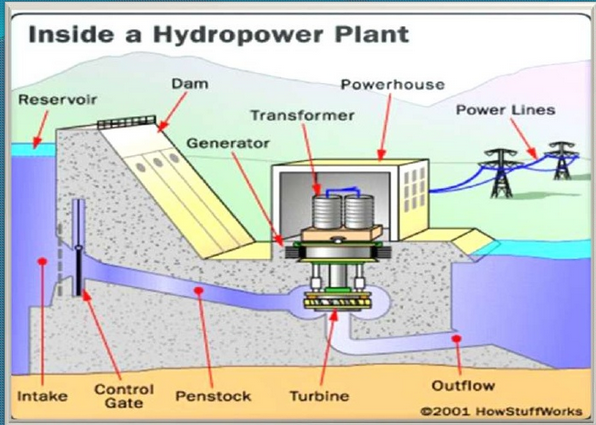
Operation principle:
The water is collected into a dam so it serves as a water reservoir. The potential energy for further work is generated by the water level difference between the dam and the turbines because the water level in the dams is very high. The next step is to convert this kinetic energy of water into mechanical energy. The water flows from a height to the turbines which have blades. The falling water has enough kinetic energy that when they strike hard with the blades of the turbines, they start spinning which means that the kinetic energy is converted into mechanical energy. The turbines resemble a lot with the windmills in which wind energy is used instead of water. But the turbines use potential and mechanical energy of falling water to convert into work. The shafts of the turbines convert the mechanical energy into electric energy. Basically, the generators work on the principle of magnets which is that when you pass a magnet near a conductor, electric current flows through it.
Wind power
The installed capacity of wind power has increased from 4.8 MW in 1995 to more than 239 GW in 2011. Today, each wind turbine could generate as much electricity as a conventional power plant. Wind energy has made its most significant contributions in China, the US and Germany, where the cumulative installed capacities is 62, 47 and 29 GW, respectively.
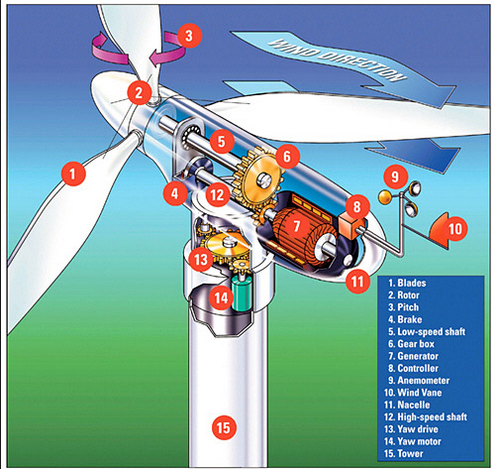
Operation principle of a wind turbine
The wind turns two or three propeller-like blades around a rotor. The rotor is connected to a main shaft, which spins a generator to create electricity. Wind is a form of solar energy and is a result of the irregular heating of the atmosphere by the sun, the irregularities of the earth's surface, and the rotation of the earth. Wind turbines convert the kinetic energy in the wind into mechanical power. This mechanical power can be used for specific tasks (such as pumping water) or a generator can convert this mechanical power into electricity.
Solar power
During the two last decades, the economic feasibility of solar power for residential, commercial and industrial consumption has been investigated by researchers. Industrial countries like Japan and Germany are looking for alternative sources of energy such as solar power due to the limited availability of natural primary energy sources. In early 1990s, Japan started to take advantage of large-scale electricity generation by solar photovoltaic (PV), and was soon followed by Germany. Currently, both countries have taken the lead in the manufacture and production of solar power technologies.
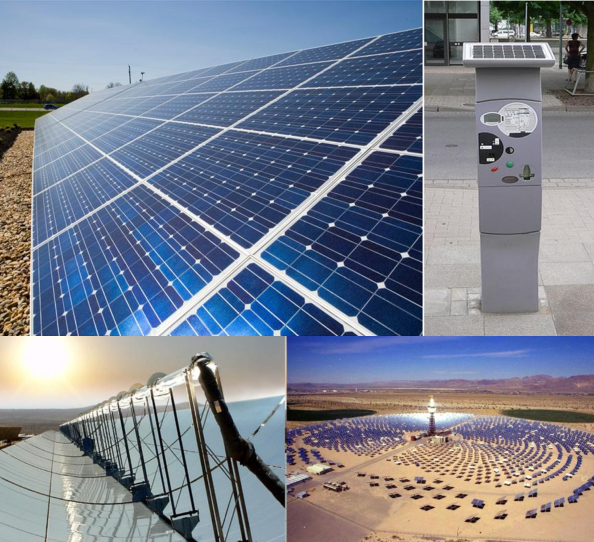
There are several kinds of solar techniques that are currently available. However, each of them is based on quite different concepts and science and each has its unique advantages. Generally speaking, non-concentrated photovoltaic solar panels (PV) and concentrated solar power (CSP) are the two most mature technologies. They have been commercialized and expected to experience rapid growth in the future.
Photovoltaic Solar Panels (PV)
Photovoltaics (PV) is a method of generating electrical power by converting solar radiation into direct current electricity using doped semiconductors that exhibit the photovoltaic effect.
Bombardments of photons from solar rays energize electrons which flow from the negative part to the positive part through the conductive circuit:
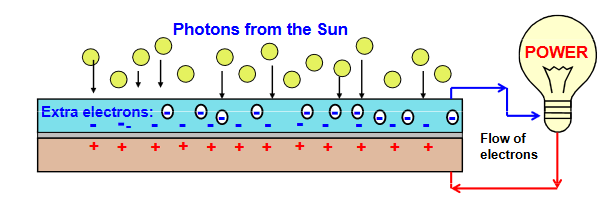
Photovoltaic power generation employs solar panels composed of a number of solar cells. Photovoltaic solar panel is the most commonly used solar technology to generate electricity energy.
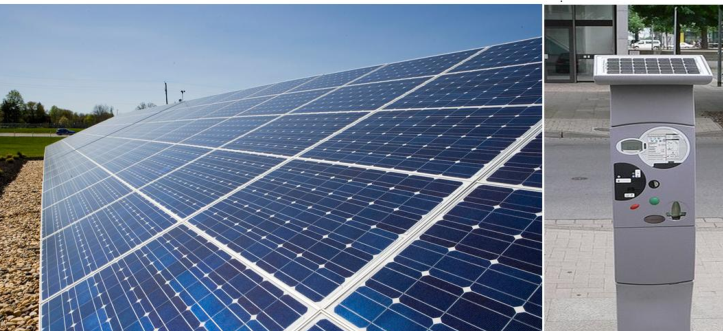
Concentrated Solar Power (CSP)
Concentrated solar power systems use mirrors or lenses to concentrate a large area of sunlight, or solar thermal energy, onto a small area. Electrical power is produced when the concentrated light is converted to heat which drives a heat engine (usually a steam turbine) connected to an electrical power generator.
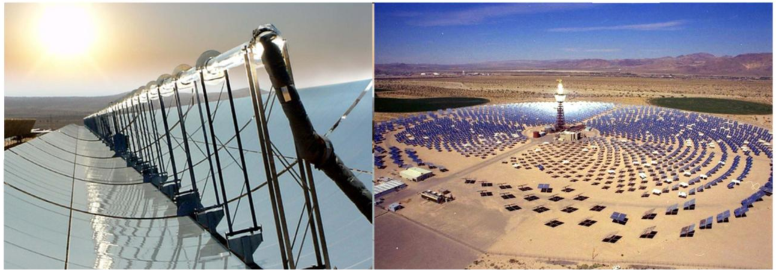
Unlike the photovoltaic solar cells, converting energy from sunlight to electricity by CSP systems is based on the application of heat engine rather than photovoltaic effect which is directly transfer photon energy into electricity energy.
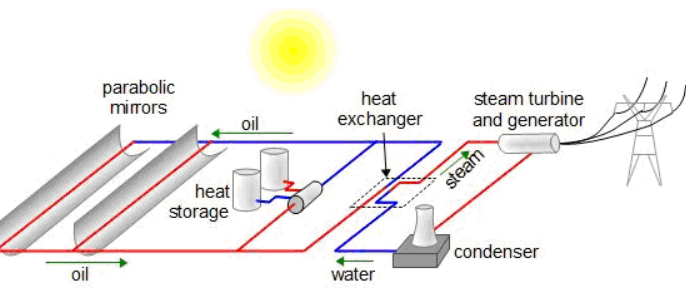
The figure illustrates how a commonly used parabolic CSP system works. The collectors concentrate the sunlight, collect it as heat energy and store it. Then, the heat energy is used generate steam that runs heat engines to produce electricity, which is transferred to the grid. Heat engines have been around since antiquity; but, were only made into useful devices during the industrial revolution. They continue to be developed today and are very mature technologies. Most of the electricity generated today is by heat engines driven by burning of fossil fuels or hydropower. Their efficiency is limited by the laws of thermodynamics.
Geothermal
Geothermal is a type of thermal energy generated and stored within the Earth. It has been used throughout history for bathing, heating and cooking. While geothermal energy is available worldwide, there is an important factor called the geothermal gradient that indicates whether a region is a favored place. It measures the rate
at which the temperature increases as the depth of the Earth increases. For example, the average geothermal gradient in France is 4˚C/100m with a range of 10˚C/100m in the Alsace region to 2˚C/100m in the Pyrenees Mountains. In Iceland and the volcanic regions, the gradient can reach as high as 30˚C/100m. The geothermal gradient is not the only tool used to measure the accessibility of geothermal energy. The permeability of rocks, which determines the rate of flowing heat to the surface, is considered to be another important measure in the availability of geothermal energy. Geothermal energy has a major advantage compared to wind and solar energy in that it is available 24 hours a day through the year.
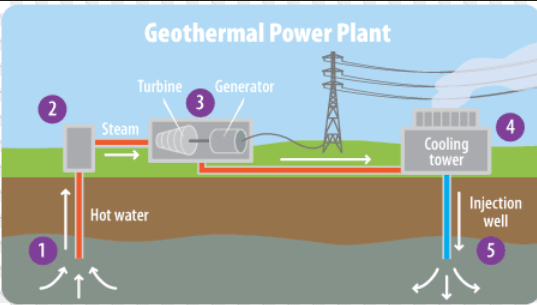
Created with the Personal Edition of HelpNDoc: Easy EPub and documentation editor